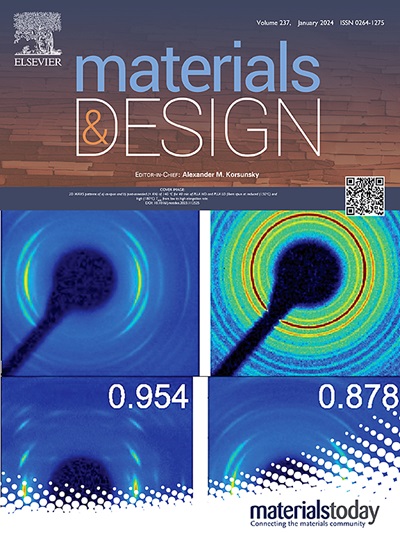Self-locking Fe-based shape memory couplers: Insights into SME and interface contact mechanics
IF 7.9
2区 材料科学
Q1 MATERIALS SCIENCE, MULTIDISCIPLINARY
引用次数: 0
Abstract
Fe-based Shape memory alloys (Fe-SMAs) have been extensively utilized in a variety of innovative engineering applications. Notably, Fe-based shape memory couplers present an alternative to welded and machined mechanical joints, offering advantages such as self-locking assembly and reduction of stress concentrations. However, further characterization in terms of multiaxial shape memory effect (SME) and, geometrical as well as implementation parameters is crucial for the purpose of reliable strength evaluation. While significant progress has been made toward understanding the uniaxial characteristics of the SME—driven by major developments and widespread use of such materials—the behaviour of Fe-SMAs under complex loading conditions, such as those involving multiaxial phase transformations, remains less well understood. During the pre-straining process of Fe-SMA tubes, non-uniform biaxial stress-state leads to a complex stress-induced martensite formation, posing challenges in the assessment of SME. Nonetheless, it is feasible to interpret the overall SME performance based on the resultant pressure exerted by the Fe-SMA tube on a substance, thereby limiting its free recovery. This study explores the impact of heat-treatment, pre-straining level, activation temperature and wall-thickness on interface contact pressure, providing insights into the gripping capacity in Fe-SMA tubes, which is crucial for evaluating the strength of shape memory joints. Via coupling of analytical models with results extracted from an experimental campaign, the resultant pressure at the interface throughout the course of activation is quantified, aiding to assess the SME performance. The obtained results highlight the complex interaction between post-processing and structural parameters, shedding light on the design and implementation of Fe-SMA coupling components with enhanced SME performance.

自锁铁基形状记忆耦合器:对SME和界面接触力学的见解
铁基形状记忆合金(fe - sma)在各种创新工程应用中得到了广泛的应用。值得注意的是,铁基形状记忆耦合器提供了焊接和机械加工连接的替代方案,具有自锁组装和减少应力集中等优点。然而,为了可靠的强度评估,进一步表征多轴形状记忆效应(SME)和几何以及实现参数是至关重要的。由于这些材料的重大发展和广泛使用,在了解sme的单轴特性方面取得了重大进展,但fe - sma在复杂加载条件下的行为,例如涉及多轴相变的情况,仍然知之甚少。在Fe-SMA管材预应变过程中,双轴应力状态不均匀导致了复杂的应力诱发马氏体形成,给SME的评价带来了挑战。尽管如此,根据Fe-SMA管对物质施加的合成压力来解释SME的整体性能是可行的,从而限制了其自由回收。本研究探讨了热处理、预应变水平、激活温度和壁厚对界面接触压力的影响,为Fe-SMA管的握持能力提供了见解,这对评估形状记忆接头的强度至关重要。通过将分析模型与实验结果相结合,可以量化整个激活过程中界面处的合成压力,从而有助于评估SME的性能。得到的结果突出了后处理和结构参数之间复杂的相互作用,为提高SME性能的Fe-SMA耦合元件的设计和实现提供了启示。
本文章由计算机程序翻译,如有差异,请以英文原文为准。
求助全文
约1分钟内获得全文
求助全文
来源期刊

Materials & Design
Engineering-Mechanical Engineering
CiteScore
14.30
自引率
7.10%
发文量
1028
审稿时长
85 days
期刊介绍:
Materials and Design is a multi-disciplinary journal that publishes original research reports, review articles, and express communications. The journal focuses on studying the structure and properties of inorganic and organic materials, advancements in synthesis, processing, characterization, and testing, the design of materials and engineering systems, and their applications in technology. It aims to bring together various aspects of materials science, engineering, physics, and chemistry.
The journal explores themes ranging from materials to design and aims to reveal the connections between natural and artificial materials, as well as experiment and modeling. Manuscripts submitted to Materials and Design should contain elements of discovery and surprise, as they often contribute new insights into the architecture and function of matter.
 求助内容:
求助内容: 应助结果提醒方式:
应助结果提醒方式:


